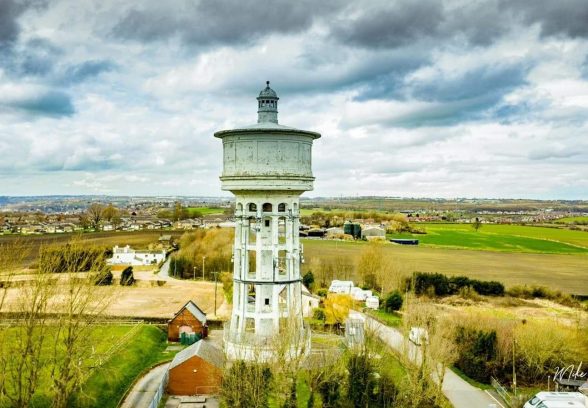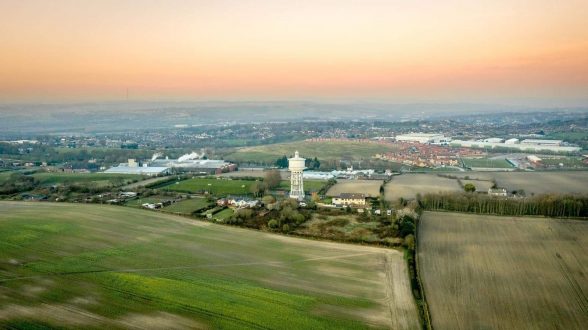This website uses cookies
This website uses cookies to enable it to function properly and to analyse how the website is used. Please click 'Close' to accept and continue using the website.



Mike Robinson Photography
Wakefield’s landmark neoclassical water tower which sits on a high ridge and can be seen for miles around has been listed at Grade II following a campaign by local residents and support from the Twentieth Century Society.
C20 Society caseworker Coco Whittaker said: “The 1920s Gawthorpe Water Tower is a much-loved feature of the Ossett landscape in Yorkshire. We are delighted it has been listed and hope this will ensure it is protected and maintained for the benefit of future generations.”
Chris Burley, who organised the local campaign and submitted the listing application, commented: “I’ve lived close to the tower all my life and seen it as great local attraction. But this all started with my wife Joanne one day saying, ‘it needs a good paint job, it’s looking tatty.’ We tried a lot of ways to get it done. It needs substantial repairs and you can’t paint it until then but there is no funding for this, meaning it would fall apart and then be demolished which we couldn’t see happen. After great success with the local community and a meeting to discuss, we applied to get it listed to save it. Now we can concentrate on repairs and maintenance.. then painting.“
Historic England’s listing report states: “As a structure primarily serving a functional purpose one might expect it to simply be utilitarian in design, but instead it is treated architecturally, demonstrating that aesthetic considerations were clearly just as important as functionality. It is clear that the local board intended to make an impressive visual statement reflecting the civic pride of the township in this provision, and the tower’s elegant rotunda design successfully achieves this, with its panelled tank and domed cupola, all in reinforced concrete.
“Stylistically the tower compares very favourably with other listed concrete water towers, including the water tower at Rockwell Green, Somerset (about 1930, Grade II) and the water tower at Goole (completed 1927, Grade II). In a wider context, numerous listed examples of water towers serving private country estates survive, including the ornamental water tower and sun room at Wappingthorn, West Sussex (about 1930, Grade II), which is more like a folly, the near-identically styled tower at St Antony’s Convent, Leweston, Dorset (about 1930, Grade II), and the vernacular dovecote-style water tower at Lytes Cary, Somerset (about 1934, Grade II), but there are far fewer listed municipal towers. Gawthorpe Water Tower is a notable example of this type of public tower.

Gawthorpe Water Tower is also of special historic interest in reflecting the developments in public water supply provision that took place in England in the latter half of the C19 and early C20. As the link between cholera and foul water was discovered, and piped water supplies were established for all the population and no longer just for the wealthy, Gawthorpe Water Tower is important as a physical reminder of these significant advancements in health and sanitation.
Before the 1870s there was no public water supply in Ossett and private wells were inadequate and heavily polluted. In the 1870s the Local Board of Health proposed a piped water supply, the provision of drainage, and a sewage works. Water was initially brought from Batley and stored in a covered reservoir constructed at Gawthorpe in 1876. However, Ossett still lacked a permanent water source and the demands of businesses and an increasing population led the town council to enter into a 30-year contract with the Dewsbury and Heckmondwike Waterworks Board in 1907 to take water from its reserves. As demand grew further the Board was unable to supply enough water for Ossett and a new source was required. An Act of Parliament in 1922 enabled the provision of a new water supply and the former Pildacre Colliery was selected as the site for a waterworks. In 1910 the colliery had suffered a devastating flood and subsequently closed, and it was this floodwater that became Ossett’s new water source.
Pildacre Waterworks was constructed between 1922 and 1928 at a cost of £48,667, and was opened on 25 February 1928 by Councillor J H Moorhouse, Chairman of the Ossett Water Committee. During the same period Gawthorpe Water Tower was constructed approximately 1.25 miles away to the north, adjacent to the covered Gawthorpe Reservoir off Chidswell Lane. The tower is similar in design to the first constructed public water tower, in Newton le Willows, Merseyside (1904, now demolished), which was designed by Reed and Waring, consulting engineers, and constructed by Cubitts and Co. Water was drawn up from the former mine workings and pumped to the tower from the waterworks by two engines known as Maud and Edith where it was used to store drinking water for the village of Gawthorpe. A further covered reservoir was constructed to the south of the tower in the late C20. By the early 1970s the water source at Pildacre had almost dried up, and from 1974 water was instead brought from Fixby Water Treatment Works, Huddersfield and the waterworks at Pildacre closed. Gawthorpe Water Tower ceased active use for water storage in around 2006, but it remains in use in 2020 as a host for telecommunications equipment.
If you would like to get involved in helping to restore Gawthorpe Water Tower please visit the local campaign group’s Facebook page.

Become a C20 member today and help save our modern design heritage.